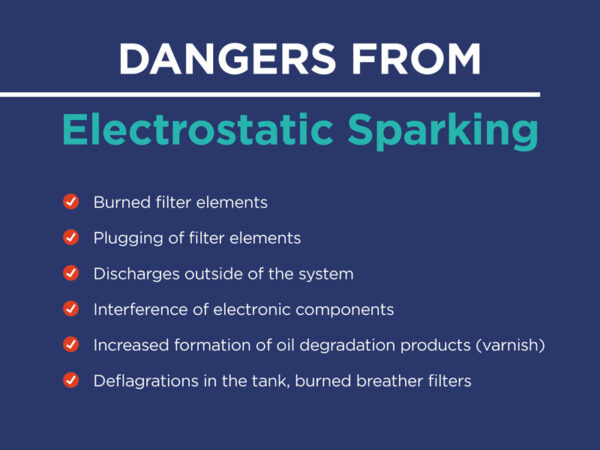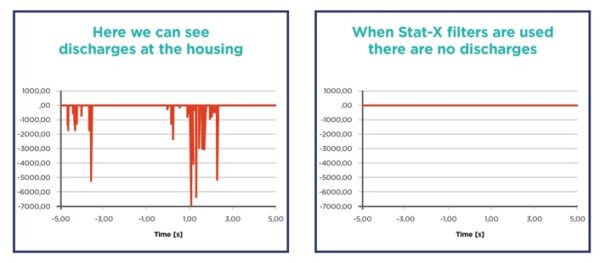Electrostatic discharge in your hydraulic system?
Clicking in your hydraulic filter housing?
If you hear a clicking or low buzzing noise it may be a sign of electrostatic discharge. Simply put, electrostatic discharge (ESD) is the result of static build-up, similar to how you can generate static build up between a balloon interacting with clothing.
Except in industrial instances, the static is often the result of the interaction between the hydraulic fluid and the filter media. Which can have serious consequences to the safe and optimal running of machinery.
As a potential danger from sparking may include burned filter elements. The burnt holes in the filter media could quickly turn your 5-micron filter into a 200 micron filter! And therefore in effect increase the risk of particulates within your system – which could lead to further issues.
How does electrostatic discharge occur?
There are two key factors that influence the likelihood of ESD. Firstly, is the conductivity of the oil. Low conductivity oils of below 500pS/m is one contributing factor. These are typically heavily refined group 2 and 3 base oils and those lacking in heavy earth metals such as zinc, which is becoming the norm in modern oil manufacturing.
Secondly, is the workload at the filter element. If this is greater than 0.01 L/min/cm², then that will also increase the risk of arcing.

The sparking caused by static build up can reach temperatures up to 10,000°C, and this extreme heat can break the fluid and cause the formation of sludge and varnish – more can be read on this here: Is it time you vanished the varnish in your hydraulic system?
How can electrostatic discharge be detected and deterred?
We always would recommend regular oil sampling as it can help to detect and prevent a variety of issues. And, in the case of spotting ESD, oil sampling and performing conductivity measurement is a good place to start.
If you have electrostatic discharge taking place within your system, you may notice that your oil will darken, and laboratory tests may detect an increased level of varnish.
You may also be able to detect the occurrence of electrostatic discharge if you listen and hear the static noises of sparks discharging within the filter housing. The opening of this HYDAC video of a test rig gives a good indication of what to look out for.
You may think that simply making your filter conductive is the answer, but it’s not. You need to change the interaction between the oil and filter in the first place. This can be achieved by using HYDAC’s patented filter solutions that prevent static build up at source.
HYDAC’s Stat-Free® and Stat-X® filter technologies, that we stock and supply, ultimately extend your fluid lifetime and protect your components even in extremely critical systems with excellent, fine filtration.
This leads to increased safety for employees, working environments and machinery due to a proven reduction of electrostatic arcing. It can also reduce unplanned downtime and reduce maintenance costs. You can also extend your oil service intervals and reduce the build up of varnish.
An industrial environment that is often at risk of ESD, owing to the low conductivity of the oil, is often in turbines. This video shows the results of using HYDAC Stat-X in mobile and offshore applications as well as turbine lubrication. With the graph showing the effectiveness of a HYDAC Stat-X filter within turbines.
Turbine Lubrication

Graph: Data sourced from HYDAC
If you would like to know more about increasing safety and the life of your machinery through the prevention of electrostatic discharge, contact our team.
You can read more about electrostatic discharge here and varnish here.

